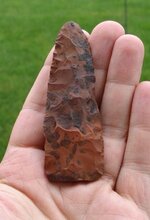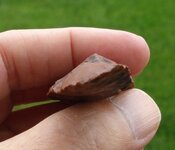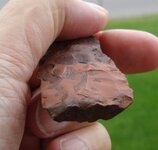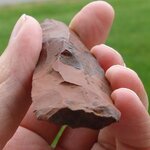uniface
Silver Member
Red Jasper knife from somewhere in Tennessee. Heavy river scunge partly cleaned.
Basal thinning strikes made me suspect (hope ) Paleo time frame, but not so. The base being fire-popped off I could see from the pictures (ebay).
) Paleo time frame, but not so. The base being fire-popped off I could see from the pictures (ebay).
A big, unremoveable hump kept it from being a point ; pretty carefully re-sharpened as a knife. Resharpening (tip half) is distinctly right-beveled, which is probably the key to its age.
Since my (relative) familiarity with points stops with Early Archaic (left beveling), I'm hoping someone familiar with east-central artifacts can jump in here and narrow it down further than just not paleo and not early archaic either.
Thanks in Advance
Basal thinning strikes made me suspect (hope
 ) Paleo time frame, but not so. The base being fire-popped off I could see from the pictures (ebay).
) Paleo time frame, but not so. The base being fire-popped off I could see from the pictures (ebay).A big, unremoveable hump kept it from being a point ; pretty carefully re-sharpened as a knife. Resharpening (tip half) is distinctly right-beveled, which is probably the key to its age.
Since my (relative) familiarity with points stops with Early Archaic (left beveling), I'm hoping someone familiar with east-central artifacts can jump in here and narrow it down further than just not paleo and not early archaic either.
Thanks in Advance

Attachments
Upvote
0









